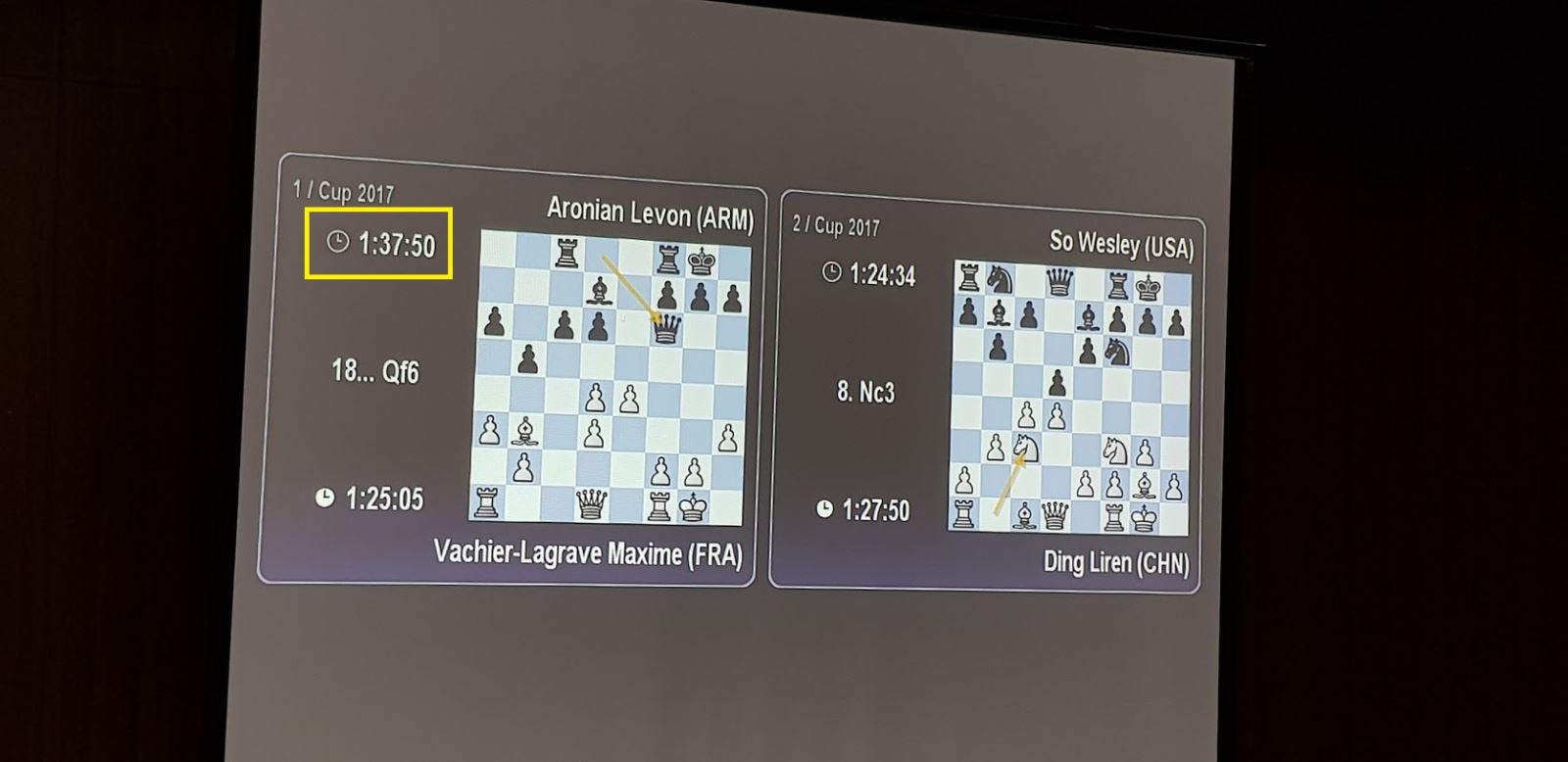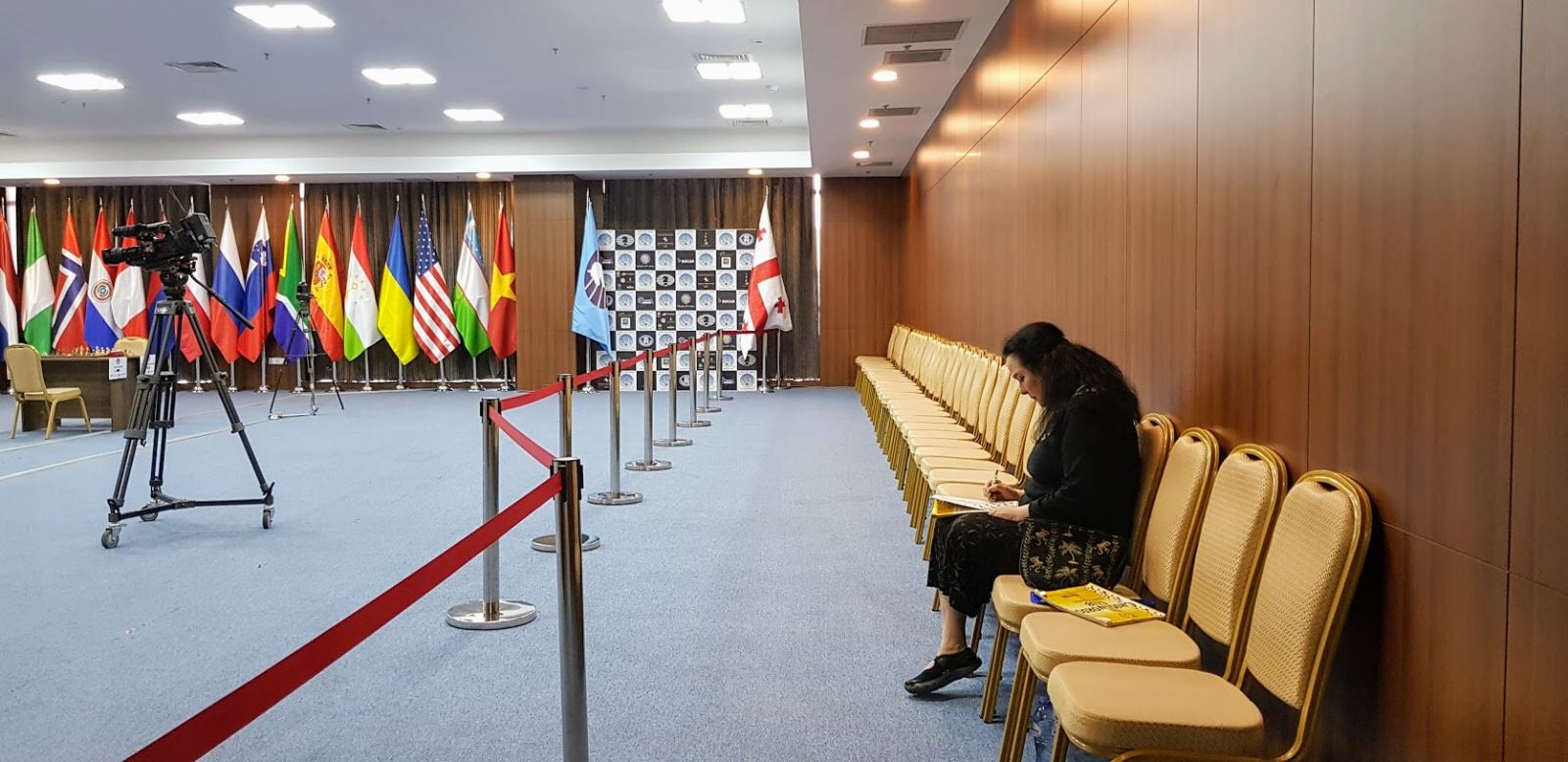



After game one of the semifinals ended Ding Liren was a happy man. He had dodged a bullet and had somehow survived against his adversary Wesley So. Apart from having black in the next game (game two), Wesley also had to face the unpleasant feeling of going back to the room and switching on the engine (yes, he did that), and finding out that he had an advantage worth nearly four pawns. Yes, it was heartbreaking for Wesley, but he calmed himself down and got ready for a fresh new day.
On September 20th, Ding was the first to arrive to the hall with his coach Xu Jun.
Ding Liren and his coach Xu Jun come out of the elevator on the second floor where the tournament is being held in Hotel Hualing | Photo: Amruta Mokal
With the white pieces Ding has been a very dangerous opponent. He beat Wang Hao and Richard Rapport without giving them any real chance. Naturally Wesley decided to stay as solid as possible and went for the QGD against Ding's Catalan. But the Chinese player had a surprise cooked up there too:
Wesley tries to remember his analysis against Ding Liren's relatively rare 6.b3!? | Photo: Amruta Mokal
Wesley took his time to find the best setup for Black. Of course 6.b3 was not the most ambitious move, but Ding had more surprises in store for his opponent.
The idea of the move Ne1 is to put more pressure on the d5 point and at the same time reroute the knight to better squares. The best ones would be from e1 to c2 and then the knight could jump to e3 or d4. Here's a video where I try to explain the virtues of the move 10.Ne1.
I am not sure if 10.Ne1 is an earth shattering new move, but it surely caught Wesley So off guard
Note: After the move 10...Rc8 11. cxd5 Nxd5 12.Nxd5 Bxd5 13.Bxd5 exd5 I suggest that White can go Ng2. However, this is not a great move because Black can play 14...c4! with an excellent position. Hence the better continuation would be 14.dxc5 followed Ng2.
Within just few moves after the opening, Wesley So landed in a very dangerous position.
Usually when you reach a symmetrical position, the thing that is the most important is the activity of your pieces. In this position, White is extremely active and it is very difficult to neutralize his initiative. After carefully building up his position Ding found himself in a position where he had the chance of his life. If he found it, he would have reached the Candidates, if not he would have to play the tiebreaks!
White has the very powerful move 37.Rh8! as was pointed out by the FIDE press officer Anastasiya Karlovich. Black would have to reply with 37....Rc7 and after 38.Rdd8 Rxc5, White has the ultra strong 39.e5! shutting down the doors for black's king. It is only through some miraculous moves that Black is able to avoid getting mated. If you follow the line in the analysis, White reaches the following position:
This video explains to you in detail the excellent opportunity that Ding Liren missed
After Ding missed this opportunity, So was like a machine, making one good move after another, and without any difficulties salvaged the half point.
Liren against Wesley's chair! | Photo: Amruta Mokal
Wesley So speaks to ChessBase after his game and tells us about Ding's opening idea, where he himself went wrong and what his opponent could have done better
The game between MVL and Levon Aronian was one that ended in just 15 minutes. But I wouldn't call it one of those boring dull draws. Aronian showed a relatively new and rarely played idea, and equalized without any difficulties.

Aronian's final move of the game 18...Qf6. Look at the time on his clock! He has gained eight minutes!
Both the players were in a hurry to make their moves and finish the game! | Photo: Amruta Mokal
"My friend recommended this move 9...Bg4," says Aronian. "I was not too sure about it, but I think it is a very good move and decided to try it out." All of Black's moves were logical and strong. In the final position there is nothing much that MVL can do, so he offered a draw. What I find interesting is the clear logical play by Levon. All his moves were easy to understand and it's not so straightforward to find what is the improvement that White should opt for if he wants to play the 6.d3 line again.
There is always something to learn from super grandmaster battles!

After the game ended, both the players were in a jovial and relaxed mood | Photo: Amruta Mokal
Levon Aronian talks about his opening innovation and also what went wrong in yesterday's game
Q: How much is the pressure, now that you are just one step away from the Candidates qualification? MVL: We live for such opportunities. There is extra pressure, but at the same time it is very exciting.
Will Aronian's idea kill the 6.d3 Ruy Lopez for White? | Photo: Amruta Mokal
A lot of experienced chess players enjoying Ding Liren's rook ending versus Wesley So in the press room

Wesley's biggest support — Lotis Key, who is always within So's sight when he is playing the game. | Photo: Amruta Mokal
Lotis loves to read and had bought her new Kindle to Tbilisi with all her favourite books loaded in it. However, the anti-cheating rules do not permit any electronic devices into the tournament hall and hence she has had to pass her time with the crossword puzzles! Her patience and composure is surely something to learn from.
The Rubinstein/Keres/Korchnoi of women's chess visited the playing hall today. Do you recognize her? | Photo: Amruta Mokal
Although the course of the two matches have been completely different, they have both come to the tiebreak stage. Levon Aronian has beaten players like Hou Yifan and Maxim Matlakov in the tiebreaks, while MVL has got the better of Alexander Grischuk and Peter Svilder. Maxime's scorecard definitely looks more impressive. It wouldn't be wrong to say he is the mild favourite going into the faster time controls. As for Ding Liren and Wesley So, they both haven't been tested enough in the tiebreaks. Ding Liren has never had to play the 10' + 10" rapids, while Wesley So had to do it only once against Bluebaum. The defensive resources and tenacity that both So and Ding have shown against each other makes me feel that this match will go all the way down to the wire. There is really nothing much to choose between them.
Will it be Levon Aronian versus Ding Liren or... | Photo: Amruta Mokal
...MVL against Wesley So? | Photo: Amruta Mokal
Or MVL against Ding or So versus Aronian! All will be revealed on the 21st of September. Stay tuned!
Initial moments of game two of the Semi-finals
GM Genna Sosonko speaks about MVL-Aronian and Ding-So
The second floor of the Hualing Hotel is where all the action is taking place. We take you on a short tour.